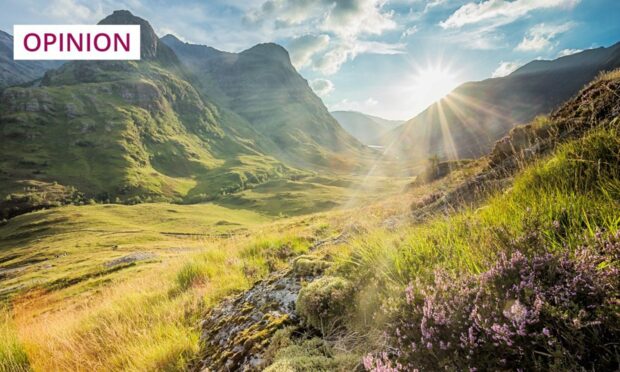Landowners seem to be seeking a status quo transition, but the fact remains that community ownership is better for people and the planet, writes David Ross.
Last month, the landowners’ organisation Scottish Land & Estates (SLE) launched “a landmark report” which, it claimed, should be a “game-changer” in how landowners are viewed.
The publicity material said the report dismissed “the outdated image of ‘lairds’ that so often mars the debate around land use and ownership.” It counselled that those involved in Scotland’s land reform debate “should recognise the value of estates to modern-day Scotland rather than become mired in historical arguments.”
Well, that’s us telt! Whatever you do, don’t mention the Clearances.
The report in question was SLE’s submission to the Scottish Government’s consultation on the “wellbeing economy”, and it highlighted the contribution made by Scotland’s rural estates – from providing homes for 13,000 families and land for 14,000 rural enterprises, to accounting for 58% of Scotland’s renewable energy generating capacity and supporting one in 10 rural jobs.

Plenty more statistics underline landowners’ contribution. Implicit is the idea that larger-scale units contribute most efficiently to the nation’s wellbeing.
But, as Andrew Thin, chair of the Scottish Land Commission, tweeted in response to the SLE report: “No question that Scotland’s land plays a vital role in our wellbeing economy, but not obvious that it needs to be parcelled up into estates in order to do so”.
One respondent opined, perhaps with tongue in cheek, that if huge estates are necessary for Scotland to achieve its vital goals, then wholesale land nationalisation is the logical progression.
That’s not going to happen. But, the SLE document can be seen as part of a determined PR campaign by landowners ahead of MSPs debating further land reform later this year.
Don’t say the L word
There is no doubt that the landholdings of SLE members are nationally significant, as the report underlines – “Scotland’s 1,125 rural estates cover a combined area of approximately 4.1 million hectares (10.13m acres), around 57% of Scotland’s rural land.”
A report for the House of Commons Scottish Affairs Committee in 2014 said that 0.025% of the population owned 67% of privately owned rural land.
It could be said that some of the declared achievements of this concentrated pattern of private ownership are fairly modest, given that so much of the countryside is involved. But the estates are valuable, and getting more valuable.
The price of Scottish land continues to rise, boosted by new buyers – green (oops, almost said the L word, but here’s another) landlords, seeking to invest in the natural capital of the estates. This allows them to “greenwash” their day-to-day commercial activities, and access government support for the likes of tree-planting and peat restoration.
Recently, The P&J reported the call for a rich list of the top 100 landowners in Scotland to be published, with details of how much public money they have been receiving for their estates.
Former Scottish cabinet minister and Highlands and islands MSP Peter Peacock said that local communities were being priced out of the land market by already rich people; people who see the value of their assets increase daily, while benefitting from the huge amounts of public money they receive for forestry and environmental improvement, as well as agricultural subsidy.
Only 3.1 % of rural Scotland is community-owned
Some may see the SLE document in part as a riposte to the Just Transition Commission’s report published last summer. It advised ministers that the socially and economically fair move to a net zero carbon economy they sought, a just transition, faced a major barrier in “extreme asymmetries” in land ownership – in other words, the large estates. But the commission went further.
The forthcoming land reform bill should increase community rights and support. MSPs must ensure it does
“In delivering a just transition, the Scottish Government must aim to tackle the root causes of these severe inequalities in land ownership and governance, which are fundamental to issues facing nature, economic development, housing, and food systems,” it said.
The commission saw greater potential in land owned by local communities, in the existential fight against climate change. But, at present, that only represents 3.1 % of rural Scotland.
We are hearing alarmingly little about the drive to net zero in the current SNP leadership contest. If the Scottish Government is still committed to a just transition away from oil and gas, that 3.1% must rise.
The forthcoming land reform bill should increase community rights and support. MSPs must ensure it does. As a first step, they should form a cross-party land reform group to drive the agenda. It would be a fitting way to mark the 20th anniversary of the groundbreaking Land Reform (Scotland) Act 2003. It is concerning that such a group has not been formed in the intervening two decades.
Landowners, meanwhile, seem to be seeking a status quo transition, with their existing landholdings at the heart of the climate change fight, justified by their scale. This would suggest that, in countries which don’t have such huge estates owned by so few, climate change efforts are less effective. There is scant evidence of that.
David Ross is a veteran Highland journalist, author and a supporter of Community Land Scotland



Conversation